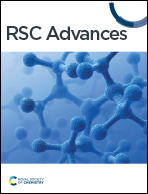Achieving stable photoluminescence by double thiacalix[4]arene-capping: the lanthanide-oxo cluster core matters†
Abstract
Luminescence stability is a critical consideration for applying phosphors in practical devices. In this work, we report two categories of double p-tert-butylthiacalix[4]arene (H4TC4A) capped clusters that exhibit characteristic lanthanide luminescence. Specifically, {[Ln4(μ4-OH)(TC4A)2(DMF)6(CH3OH)3(HCOO)Cl2]}·xCH3OH (Ln = Eu (1), Tb (2); x = 0–1) with square-planar [Ln4(μ4-OH)] cluster cores and {[Ln9(μ5-OH)2(μ3-OH)8(OCH3) (TC4A)2 (H2O)24Cl9]}·xDMF (Ln = Gd (3), Tb (4), Dy (5); x = 2–6) with hourglass-like [Ln9(μ5-OH)2(μ3-OH)8] cluster cores are synthesized and characterized. By comparing 2 and 4, we find that several critical luminescence properties (such as quantum efficiency and luminescence stabilities) depend directly on the cluster core structure. With the square-planar [Ln4(μ4-OH)] cluster cores, 2 demonstrates high quantum yield (∼65%) and excellent luminescence stability against moisture, high temperature, and UV-radiation. A white light-emitting diode (LED) with ultrahigh color quality is successfully fabricated by mixing 2 with commercial phosphors. These results imply that high quality phosphors might be achieved by exploiting the double thiacalix[4]arene-capping strategy, with an emphasis on the cluster core structure.
![Graphical abstract: Achieving stable photoluminescence by double thiacalix[4]arene-capping: the lanthanide-oxo cluster core matters](/en/Image/Get?imageInfo.ImageType=GA&imageInfo.ImageIdentifier.ManuscriptID=D2RA04942B&imageInfo.ImageIdentifier.Year=2022)


 Please wait while we load your content...
Please wait while we load your content...